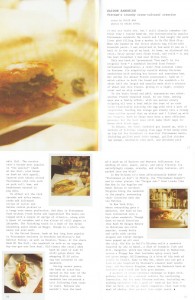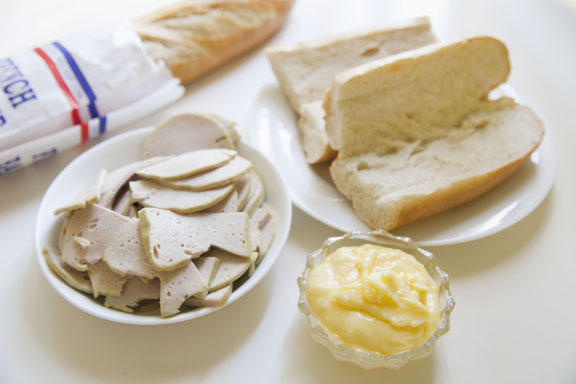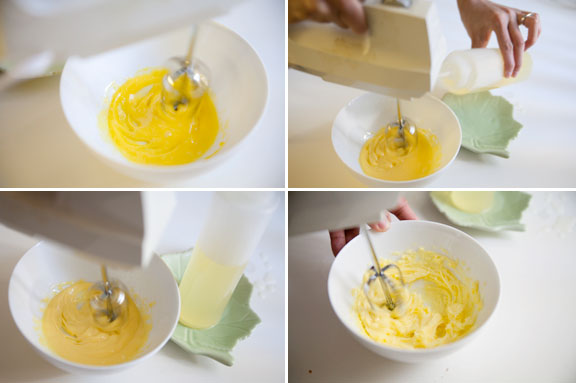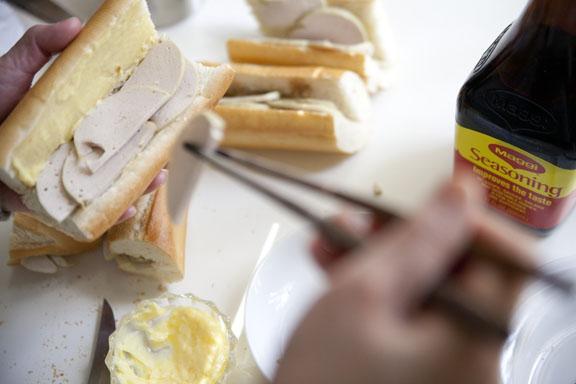 A while back, I wrote a piece on the history and appeal of banh mi, the popular Vietnamese sandwich. It appeared in Sandwich, a supplement to Meatpaper magazine’s Fall 2010 issue, and you can click on the image to the right to read the essay. (Side note: the first sentence of the piece should refer to the first time I had fresh pate… not the first time I had banh mi, which I have eaten for as long as I can remember.)
A while back, I wrote a piece on the history and appeal of banh mi, the popular Vietnamese sandwich. It appeared in Sandwich, a supplement to Meatpaper magazine’s Fall 2010 issue, and you can click on the image to the right to read the essay. (Side note: the first sentence of the piece should refer to the first time I had fresh pate… not the first time I had banh mi, which I have eaten for as long as I can remember.)
In the piece, I mention making homemade mayo with my family when I was a kid. Back in the day, we didn’t have a mixer, and so we’d make the mayo by hand, one of us furiously whisking the raw egg yolk with a pair of chopsticks while someone else slowly dripped oil into the bowl. It was really a test of patience as we agonizingly watched the thick yolk slowly grow into a light, creamy spread. But the result was always worth it — fresh mayo that we ate on crusty bread… the bread was really just an excuse for the mayo.
So here I give you my instructions on how to make mayo at home. You’ll want to use a fresh egg, as the yolk will remain raw.
Homemade Mayonnaise
Makes about 1/2 cup
1 egg yolk
1/2 cup of canola or vegetable oil (something neutral-tasting)
pinch of salt
lemon juice
mustard (optional)
Attach one beater to a hand mixer, and turn the mixer on the lowest setting. (Alternatively, use chopsticks or a whisk — but you’ll have to work fast!) Add the oil slowly, a few drips at a time, letting it gradually emulsify with the egg yolk. After you get a creamy consistency, you can start adding the oil in a thin steady stream.
If the emulsion breaks — that is, if the mayo starts to get clumpy rather than creamy, and the oil begins to separate from the cream — stop and set this broken mixture aside. Start the process again with a new yolk, but instead of adding in oil, add in bits of the broken mixture until all of that mixture is incorporated into the new yolk. Then continue adding oil in a slow, steady stream.
You can really add as much oil as you want to get your desired amount of mayo. Just keep in mind that the more oil you add, the less concentrated your mayo will be, so it is really just a matter of preference (or patience :). I usually run out of patience after about 1/2 a cup of oil, so my mayo is a bit more concentrated.
When you reach the desired amount, add a pinch of salt and a few drops of lemon juice to taste. If you like, you can also add a bit of mustard.
You can spread the mayo onto crusty bread and eat it plain, use it in sandwiches, or serve it as a condiment alongside meat, like roast chicken or steak or grilled pork chops. My family likes to do a simple baguette sandwich with homemade mayo, cha (slices of steamed pork roll), and a dash of Maggi seasoning sauce.














Connect with us